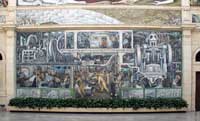
|
The central panel and part of the top panel (see below for the top details): Production of automobile exterior and final assemblyThe north and south walls are similar in that both depict two (of the four races) at the top, work at the auto plant in the large central section, and some of the other industries in Detroit in the side panels, and at the very bottom in the grisaille panels, the life of the worker continuing sequentially from the north wall to the south. (See the page on the so-called predella panels.) |
| |
|
The White and Yellow racesThe figures hold raw materials that Rivera associated with them (all elements necessary to the making of steel)--the yellow race, the most numerous and oldest, associated with sand and the white associated with lime. |
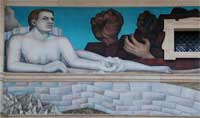
|
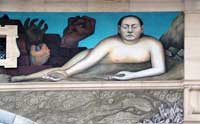
|
| |
|
| On the left hand side Rivera represents blocks of limestone; on the right he depicts fossils and quartz crystals. "Silica, a pure form of quart sand, is used for manufacturing glass and making molds, both of which are represented in the north and south automotive panels" (Downs 106). |

|

|
Geological strata |
| |
|
| Few women are depicted in the frescoes, largely because women were prohibited from doing heavy labor. See the top right where women workers are testing spark plugs and ignition systems. In the detail below, however, women are in the tour of the factory, perhaps depicted satirically since both have stern looks and obvious crosses. This kind of static respectability contrasts with the energy and diversity of the automobile workers. |
The production of the exterior of the 1932 Ford V-8 and its final assembly with pulley system and conveyor line |
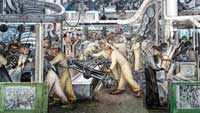
|
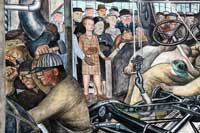
|
| |
|
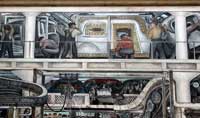
|
The welding buck |
| |
|
Working on body panelsIn the background Rivera depicts the constant temperature testing room and in the middle ground the manager/supervisor looks over the production lines. This is a portrait of M. L. Bricke, an assistant to Henry Ford in charge of production. His stern appearance no doubt underlines the fact that foremen were more interested in meeting quotas and deadlines than in the conditions for the workers. |
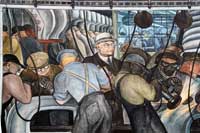
|
| |
|
Fender stamping press with welders at lower leftDowns explains that Rivera's model for this stamping machine was actually an out-dated version and speculates that he chose this version because of its visual resemblance to the Aztec deity Coatlicue. (See a sculptural representation of this deity in the National Museum of Anthropology in Mexico City.) He also altered the machine to give a sense of a head. This goddess of both creation and war demanded human sacrifice so Rivera may be suggesting that workers sacrifice themselves for the new technology. (See Downs 140, 166.) Spot and seam welders work on the left side of the press.
|
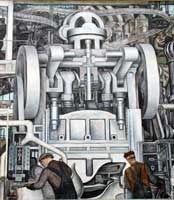
|
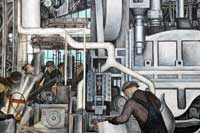
|
|
| |
|
Left corner panel: "Pharmaceuticals" and "Surgery"The pharmaceuticals industry, another industry in Detroit, is represented by a bald-headed chemist in the center and women sorting pills around him. |
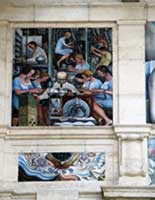
|

|
| |
|
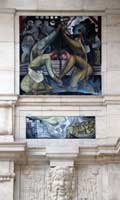
|
Right corner panel: "Commercial Chemical Operations" and "Sulphur and Potash"Stylistically, the large panel is quite different from the rest of the frescoes since, like Futurist works, it attempts to depict motion. (The two central workers are shown in two different positions.) |















